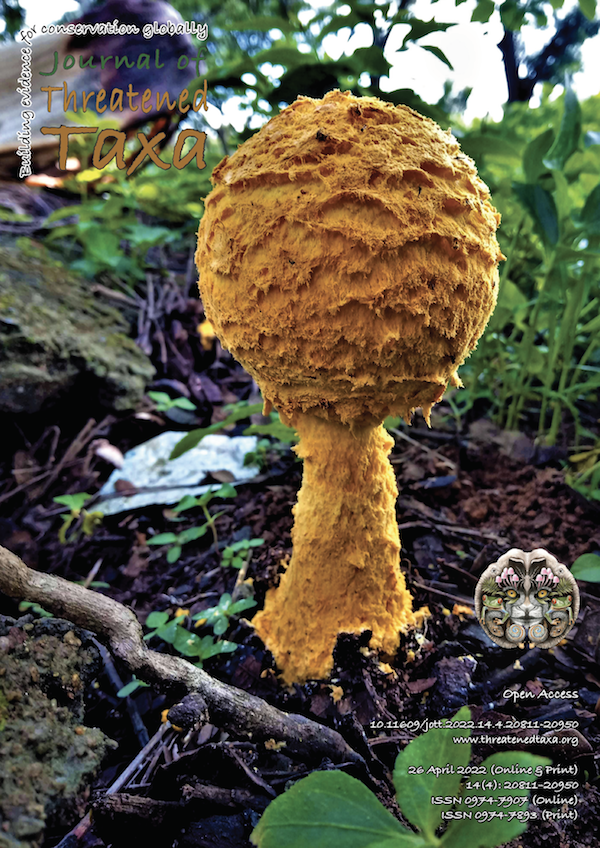Distribution records of Dormer’s Bat Scotozous dormeri (Dobson, 1875) (Mammalia: Chiroptera: Vespertilionidae) in Nepal
Main Article Content
Abstract
Dormer’s Bat is endemic to southern Asia and distributed in tropical, semi-arid, or arid climatic zones in India, Pakistan, Bangladesh, and Nepal (Srinivasulu & Srinivasulu 2019). It is insectivorous in nature and plays an important role in the natural control of insects. Roost search and mist netting were conducted during early evening to 2200 h in three sites and the species was identified by field-based morphology including medium body size, pale gray brown color on the dorsal side, buffy white ventral surface, and face is necked and uniform mid-brown in color. A total of five individuals of Scotozous dormeri were recorded from east to west Nepal and the forearm ranged 34.4–36.00 mm in length. An individual was observed in a cavity in a pillar in a wooden house at Ramjhoda, Sunsari District. Two individuals each were trapped at the Morange River, Morang District in the east and Hattikhauwa, Dang District in the west. Three localities of the species’ record lie in the dry and arid sub-tropical areas. This study records the second to fourth locality records of the species distribution to Nepal.
Article Details

This work is licensed under a Creative Commons Attribution 4.0 International License.
Authors own the copyright to the articles published in JoTT. This is indicated explicitly in each publication. The authors grant permission to the publisher Wildlife Information Liaison Development (WILD) Society to publish the article in the Journal of Threatened Taxa. The authors recognize WILD as the original publisher, and to sell hard copies of the Journal and article to any buyer. JoTT is registered under the Creative Commons Attribution 4.0 International License (CC BY), which allows authors to retain copyright ownership. Under this license the authors allow anyone to download, cite, use the data, modify, reprint, copy and distribute provided the authors and source of publication are credited through appropriate citations (e.g., Son et al. (2016). Bats (Mammalia: Chiroptera) of the southeastern Truong Son Mountains, Quang Ngai Province, Vietnam. Journal of Threatened Taxa 8(7): 8953–8969. https://doi.org/10.11609/jott.2785.8.7.8953-8969). Users of the data do not require specific permission from the authors or the publisher.
References
Acharya, P.R., H. Adhikari, S. Dahal, A. Thapa & S. Thapa (2010). Bats of Nepal. A field guide I ed. Small Mammals Conservation and Research Foundations (SMCRF), Kathmandu, 64 pp.
Advani, R. (1981). Feeding ecology and behaviour of Dormer’s bat Pipistrellus dormeri doemeri (Dobson, 1875), in Indian desert. Saugetierkundliche Mitt. 29(4): 56–58.
Agrawal, V.C. (1973). On a collection of bats from Goa. Records Zoological Survey India 67: 261–280.
Bates, P.J.J. & D.L. Harrison (1997). Bates of the Indian Subcontinent. Harrison Zoological Museum Publication, Sevenoaks, England.
Collins, J. (ed.) (2016). Bat Surveys for Professional Ecologists: Good Practice Guidelines III. Bat Conservation Trust, London, 103pp.
Dobson, G.E. (1875). On the genus Scotophilus description with new genus and species allied thereto. Proceedings of the Zoological Society of London 24: 368–373.
Khan, M.A.R. (2001). Status and distribution of bats in Bangladesh with notes on their ecology. Zoos’ Print Journal 16(5): 479–483. https://doi.org/10.11609/jott.zpj.16.5.479-83
Kunz, T.H., R. Hodgkison & C.D. Weise (2009). Methods of capturing and handling bats. pp. 3–35. In: Ecological and behavioral methods for the study of bats. The Johns Hopkins University Press, Baltimore, Maryland.
Kunz, T.H. & S. Parsons (2009). Ecological and Behavioural methods for study of batsII. The Johns Hopkins University Press, Baltimore, Maryland, 900 pp.
Molur, S., G. Marimuthu, C. Srinivasulu, S. Mistry, A.M. Hutson, P.J.J. Bates & A.R.B. Priya (2002). Status of South Asian Chiroptera Conservation Assessment and Management Plan (C.A.M.P.) Workshop Report, 2002. 317pp.
Sinha, Y.P. (1981). Studies of bats on Gujarat. Records Zoological Survey India 78: 101–112.
Srinivasulu, B. & C. Srinivasulu (2019). Scotozous dormeri, Dormer’s pipistrelle. The IUCN Red List of Threatened Species. https://doi.org/10.2305/IUCN.UK.2019-3.RLTS.T17338A22129897.en
Srinivasulu, C., P. A. Racey & S. Mistry (2010). A key to the bats (Mammalia: Chiroptera) of South Asia. Journal of Threatened Taxa 2(7): 1001–1076. https://doi.org/10.11609/jott.o2352.1001-76
Thapa, S., P. Subedi, N.B. Singh & M.J. Pearch (2012). The first record of Scotozous dormeri Dobson, 1875 from Nepal with new locality records of Pipistrellus coromandra (Gray, 1838) and P. tenuis (Temminck, 1840) (Chiroptera: Vespertilionidae). Journal of Threatened Taxa 4(4): 2481–2491. https://doi.org/10.11609/jott.o2906.2481-9

